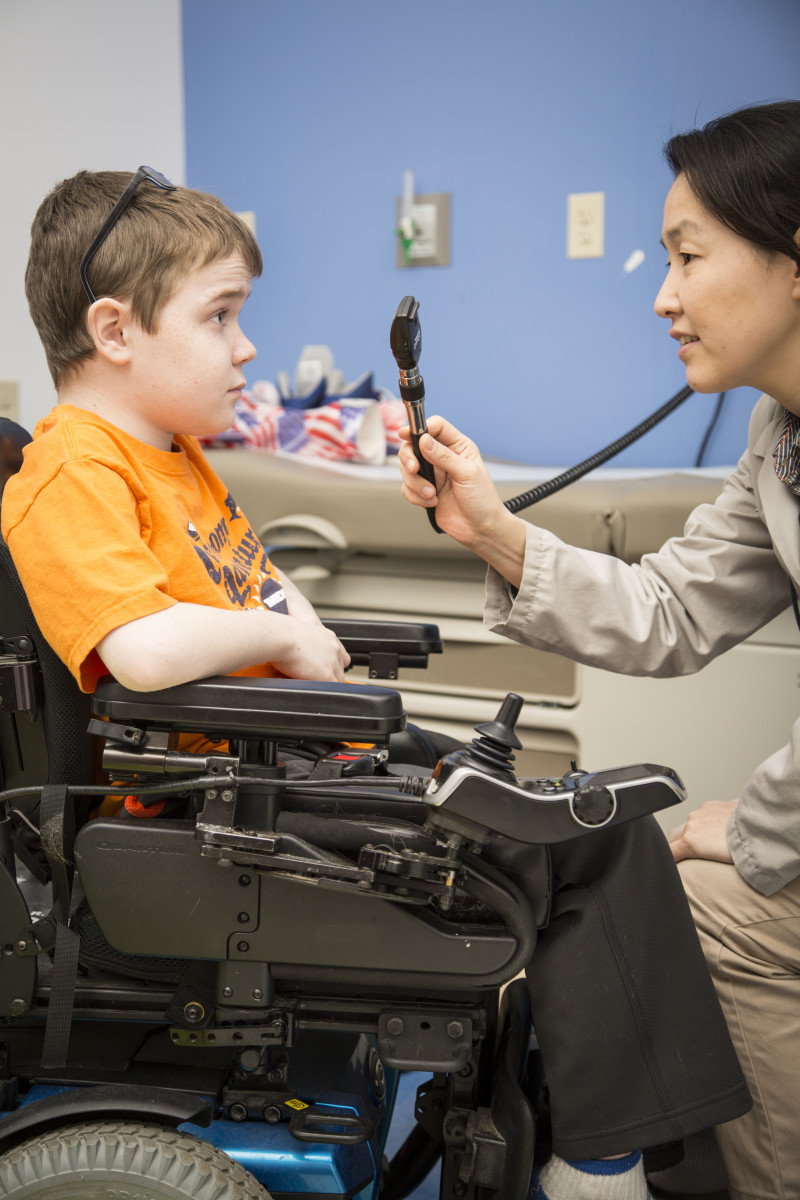MDA Executive Discusses Gene Therapies, SMN2 Modifiers, and Challenges in Treating SMA
Written by |

A child being examined at an MDA care center. (Photo courtesy of the MDA)
Gene therapies — after a tragedy kicked them back to the lab some two decades ago — are beginning to come into their own, making progress in gene-targeted and combination treatments for neuromuscular diseases that once were unimaginable.
Nowhere is this more evident than in spinal muscular atrophy (SMA), where Zolgensma, by Novartis, became the first approved gene therapy for any neuromuscular disease, and signaling what might come next.
But many challenges — from the likelihood of no “one-and-done” gene therapy for diseases like Pompe, Friedreich’s ataxia, and muscular dystrophy, to the sheer amount of vector needed for systemwide and central nervous system treatment — remain for many neuromuscular disorders, said Sharon Hesterlee, PhD, an executive vice president and chief research officer for the Muscular Dystrophy Association.
Jesse Gelsinger’s death in a gene therapy trial in September 1999 “really set the whole field back for a long time,” Hesterlee said in a wide-ranging phone interview with Bionews Services, the parent company of this website.
But the MDA “continued to invest … through that whole dry period, with the thought that this is going to work, we just have to figure out how.”
Hesterlee has a more than 20-year career in the pharmaceutical and biotech industries as well as nonprofits (including with the MDA, where she worked in drug translation and venture philanthropy from 1998 to 2009).
She welcomes gene therapy’s return, and some sense of accomplishment for the more than $1 billion the group has invested in neuromuscular disease research since its founding 1950.
“Now we’re seeing the maturation of that [gene] technology, a much better understanding of the issues, and we’re starting to see successes,” she said.
But translating Zolgensma’s success to other diseases, and understanding more fully its durability in SMA, will take time.
Up for SMA: risdiplam and combo therapies
The “next big story” for SMA is risdiplam, a disease-modifying therapy by Genentech (a member of the Roche group) now under U.S. Food and Drug Administration (FDA) review, with a decision due by May 24.
Risdiplam works by increasing the ability of the SMN2 gene to produce functional SMN protein that’s essential to muscle health. As such, it is similar to Spinraza (nusinersen), an SMN2 splicing therapy by Biogen that became the first targeted SMA therapy to earn FDA approval in late 2016.
But risdiplam is a daily oral liquid, and could be the first “at-home” therapy for people with SMA. Spinraza is given by trained personnel at select centers by intrathecal (spinal cord) injection every four months after an initial loading dose.
“It will be interesting to see how that does compare to Spinraza in basically the same role, that of a splicing modifier,” Hesterlee said.
And it’ll be interesting to see how well it works, and how often it is used, in combination therapies, she added.
“Drugs like Spinraza and risdiplam act differently than gene replacement,” Hesterlee said, “and as these and other approaches that work further downstream get approved, I think combining them is the next logical step.”
Indeed, this is already underway in SMA, given “approved treatments,” with clinical trials like JEWELFISH (NCT03032172) testing risdiplam in adults, children and infants given Zolgensma or Spinraza.
Combinations “will happen,” Hesterlee said, “whether they’re tested in clinical trials or not.” The interest for the patient is just too great.
“We’ve got this first round of drug approvals that are really remarkable, and effective,” she said. “We’ll start seeing combination therapeutics, and we’ll see improvements on this first generation, too, I think.”
A concern is whether pharmaceuticals keep developing small molecule therapies knowing that they might be used only in tandem with treatments like a gene therapy, which necessarily cuts into possible return (profits) on their investments, she said, and whether treatments that work best in combo will continue to win approval.
“Commercial models [get] really complicated when you’re trying to think about reimbursement for two drugs,” said Hesterlee, who has worked for both Pfizer and AskBio.
Hesterlee worries “that some … drugs that are sort of downstream, and aren’t as effective on their own right, might never get approved even though they could be very effective in combination.
“I think they’re going to have to stand on their own,” she said. “If they don’t get approved on their own, they probably won’t be tested again.”
Among complementary SMA treatments in development and the MDA is watching with interest is reldesemtiv, by Cytokinetics in collaboration with Astellas. A selective fast skeletal muscle troponin activator designed to slow calcium release from fast skeletal muscle fibers and improve muscle contraction, reldesemtive showed promise in a Phase 2 trial (NCT02644668) and plans are underway for further development.
“It modulates calcium in the muscle, so that even if you have a weak signal from the nerve, you get a stronger response from the muscle,” she said. “That would be a really interesting complement to any therapy: Spinraza, Zolgensma or risdiplam.”
Two ‘big challenges’ that might touch SMA
Two broad challenges exist for gene therapies in neuromuscular disorders, especially rare ones, Hesterlee said, with numerous mini-hurdles within those categories.
One is getting the therapy to all affected muscles and organs and being able to produce the huge amounts of viral vector required to transport it.
As one recent study of work into a Pompe gene therapy, by scientists that include Barry Byrne, MD, PhD, and Manuela Corti, PhD, at the University of Florida (UF), noted: the vector amounts necessary “exceed” current production techniques on a scale that “would not be suitable to support” either Phase 3 clinical trials or regulatory approval requests.
The other is the real likelihood that such treatments would have to be given again over a person’s lifetime, which means getting around resistance raised by the immune system. An immune response to a gene therapy comes in the form of antibodies against whatever virus carries the “healthy gene” to cells as a transport vector, even when that virus is re-engineered to be harmless.
“I think we know we’re going to have to treat people again, and right now what we’ve done is immunize them against the vector,” Hesterlee said. “They’re developing really high antibodies after treatment, so you can’t use the same vector.
“I think that’s going to be a big, big challenge: How do we deal with people that have pre-existing antibodies, and then how do we deal with re-dosing?” she asked.
This challenge could include SMA, because enough time has not elapsed to be certain that Zolgensma truly is a one-time treatment.
Gene therapy is “likely” much more stable in the CNS [central nervous system, the brain and spinal cord] than in muscle, Hesterlee said, but only time will tell definitively.
“People speculate ‘one-and-done‘ [but] we know that might not be the case,” she said. “We just don’t have enough long-term data to really understand how long this lasts in muscle, how long this lasts in the CNS.”
It’s “assumed” the “CNS has good stability,” she added. “But again, we don’t know.” In Zolgensma, as in other investigational gene therapies, the delivered gene sits outside a cell’s chromosome, meaning it does not integrate into the cells’ own DNA, and is not passed down to newly formed cells.
“There can be reasons you might lose these sort of extra-chromosomal pieces of DNA over time,” Hesterlee said.
Re-treatment also might be wanted for children given low and non-optimal doses in clinical trials, and that means confronting antibodies.
“There’s a lot of activity around this,” especially because re-treatment will be essential for gene therapies in many other neuromuscular diseases.
“And we’ll figure it out,” Hesterlee said, “but it isn’t gonna be in this year.”







